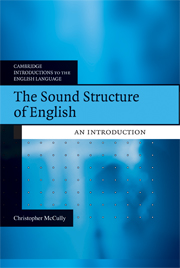Book contents
- Frontmatter
- Contents
- List of figures
- Acknowledgements
- A note on using this book
- 1 Introduction
- 2 Consonants (1): contrastiveness
- 3 Consonants (2): classification
- 4 Consonants (3): distribution
- 5 Syllables (1): introduction
- 6 Syllables (2): constituents
- 7 Syllables (3): structure
- 8 Vowels (1): short vowels
- 9 Vowels (2): long vowels and diphthongs
- 10 Vowels (3): variation
- 11 Problems, theories and representations
- Appendix: the IPA chart
- Glossary
- References
- Index of topics
- References
3 - Consonants (2): classification
Published online by Cambridge University Press: 05 June 2012
- Frontmatter
- Contents
- List of figures
- Acknowledgements
- A note on using this book
- 1 Introduction
- 2 Consonants (1): contrastiveness
- 3 Consonants (2): classification
- 4 Consonants (3): distribution
- 5 Syllables (1): introduction
- 6 Syllables (2): constituents
- 7 Syllables (3): structure
- 8 Vowels (1): short vowels
- 9 Vowels (2): long vowels and diphthongs
- 10 Vowels (3): variation
- 11 Problems, theories and representations
- Appendix: the IPA chart
- Glossary
- References
- Index of topics
- References
Summary
In this chapter …
In this chapter we build on the work we introduced in chapter 2, and look at how English consonants might be more rigorously classified. To introduce the classification we shall analyse the parameters of voice, manner of articulation, and last, place of articulation. For every consonant, then, we will be able to show that it has a three-way classification: (i) whether it's voiced or voiceless; (ii) how it's produced (i.e. whether it's a stop, or a fricative, and so on); and (iii) where it's produced.
After a discussion of these diagnostics we shall make a table of English consonant phonemes, which will appear together with their terms of classification.
Voice
Before we turn back to the diagram of the vocal tract, please repeat the small experiment you conducted – that you should have conducted – as part of the exercises you found at the end of the previous chapter.
Put your thumb and index (or second) finger lightly on either side of your Adam's apple – the cartilaginous structure below your chin, on the front part of your neck. This physical structure is usually more prominent in men than in women, but women readers will have no trouble in distinguishing it.
With your fingers lightly in place, utter a continuous ‘zzzz’ sound. Do you feel anything under your fingers? You should feel a vibration, a buzz, inside the Adam's apple. If this vibration isn't immediately tangible, try uttering a continuous ‘ssss’ sound, and then switch from ‘ssss’ to ‘zzzz’, then back from ‘zzzz’ to ‘ssss’ again. […]
- Type
- Chapter
- Information
- The Sound Structure of EnglishAn Introduction, pp. 34 - 50Publisher: Cambridge University PressPrint publication year: 2009

